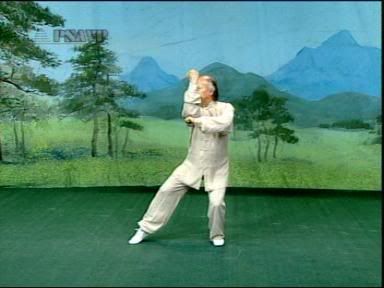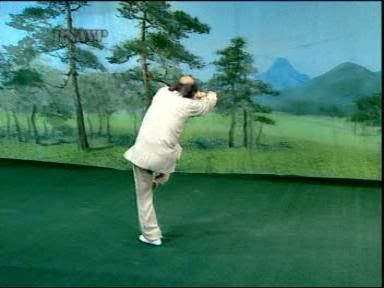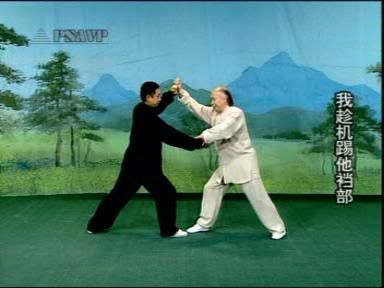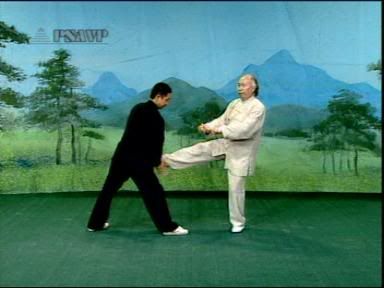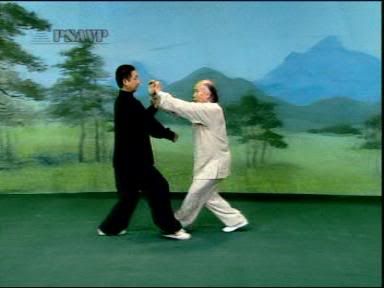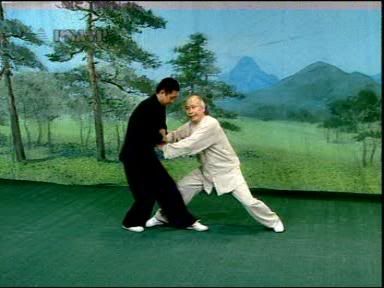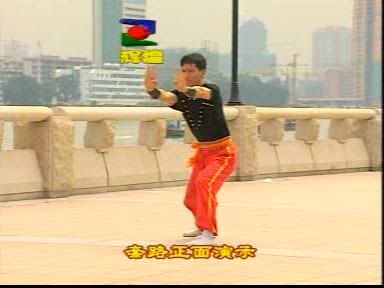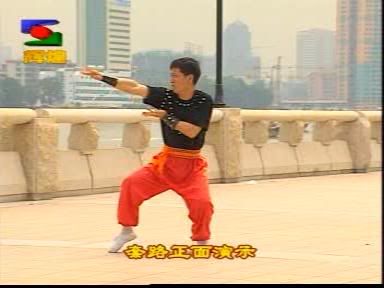|
|
Post by Eric Ling on Nov 27, 2004 0:27:21 GMT -5
Hi Evert and Russ, I was going to post separately to address this but then determined than one post is all that is necessary. I have viewed these several times:- 1. the 2 hakka clips – Lung Ying and Tiger fist (Evert) 2. the Tai Chor clip – (Russ) 3. Paiku – (Russ) The Hakka and Tai Zhu are positively from the same father even if the mother is different. The footwork, hand strikes and even kicks are from the same mould. I would stick my neck out to say; from the same place. Evert, go see for yourself. And this gets interesting; Tai Chor,in my book, is a mingling of Tiger/Crane and Lohan done in the characteristic Fukien way. Like in NCK, the crane is expressed in the “Khim”, hip-shaking energy generation, San Chiem and even in the one-knuckle punch that is so preferred by White Crane. Certain crane techniques are almost generic cutting across White Crane and NCK. Techniques like open palm slaps etc etc……. Tiger is even more visible. Besides the claws, all the low level kicks are tiger “stretching” kicks. One of TC’s highest forms is “5 Tiger Overturning River”. Lohan is also very highly expressed in TC. Any one of you got the book “Nan Quan” published in China? One of the forms in there is TC. The form is just spotted with Lohan postures. Those are the same exact postures that you’ll find in Png Chye Kim Lohan Book. And again, Lohan forms are advanced forms in TC. Crane/Tiger and Lohan – this permutation sounds familiar to you? Russ, the Paiku form in your library – what is the source? This is going to sound so funny; EVERY TECHNIQUE (except maybe the high Yoko-geri) is from Fukien Siao Lim. The block and kick in one go / kneel and rise to block and kick / double single-knuckle punch is Shao Lim Lohan. Why do I get the feeling that we are all looking at the same one big picture. Maybe, each of us is just too myopic to see the whole thing. This forum, hopefully, would break down walls and allow us the full view. THE TRUTH IS IN OUR HANDS.    |
|
|
|
Post by Eric Ling on Nov 27, 2004 0:34:43 GMT -5
Another interesting thought I just had, if the 5 elements are applied from a Taoist perspective, would their principles carry more of a Yin Yang application? Not to mean that Water subdues Fire whic subdues Metal which subdues Wood which subdues Earth and so on. Rather, if the Yang principle of Water is to have flowing attacks, what would be its Yin principle? If Earth's Yang principle was to uproot, what would be its Yin principle? I may be seriously out of line here, but is there such a thing? Warmest regards, Tze Hou No, you're not out of line. There is the concept of Ying/Yang that comes into 5 elements play in White Crane. Mildly - nothing to the degree that internal stylists apply. And also, different crane does it slightly differently. Thanks. |
|
|
|
Post by Nataraya on Nov 27, 2004 3:30:55 GMT -5
Eric, last night I was able to compare, but it did not really gave me a clear sign. In fact I have still doubts because this Southern Tai Tzu player miss many things as seen in Hakka Boxing. Again, I am judging this player because the Southern Tai Tzu system is completely new for me. To be honest I think this is the first clip that I ever saw from this Fukien system. I have no reference in that direction, I am sorry.
On the other hand I have LOADS of Hakka Boxing material in my archive,m because of my martial background and strong affinity with this art. Most of it play it so differently then the clip I saw. The comming weeks I will try to search those material and convert them step by step, so that you can look yourself. maybe it is possible to see more about Southern Tai Tzu for me.
If we are talking about a nice relation, then It is getting time that you see Tai Ji Mei Hua Tang Lang, and especially Ba Zhou. This is so close to Lung Ying, although TJMHTL is a Northern system.
Paiku: I am impressed I must say. Saw many forms and variations from Okinawa, but this one is different. I see that thgis is closer to Tai Tzu, but I notice so many characteristic Karate signs in it, such as turning, punching and the way a Age Uke is being made. But then still it breath a different 'athmosphere' and I certainly liked that!
I will absolutely observe this material and see if I can feel more overlap, but I am nit convinced. Doesn't matter, it is worth to try to analyse and search. A very nice journey to respect other systems too.
Kindest regards,
Evert.
|
|
|
|
Post by Eric Ling on Nov 27, 2004 4:09:34 GMT -5
Evert, agreed. We’ll keep looking. I do Tai Chor and had the opportunities to observe Bak Mei up-close. I understand your Sat perfectly. The stepping footwork – front leg advance, back leg follows – is all over Tai Chor. Yes, I am familiar with Tai Chi Mei Hua Tang Lang. In fact, except for Six-Combinations Tang Lung, I have “working knowledge” of the other branches. I have a CD of a very good performance – will post some pixs later. Russ, sorry I missed one of your emails. You sent it to a seldom opened box. Kong Li – the only Kong Li in my experience is from Chin Woo or JinWu (the way the Jap spells it). As a beginner in Chin Woo, you start with “Tam Tui” – 12 parts and not the “Cha” 10 sets. Then you move on to “Kong Li Quan” – a typical Northern form, very long range and very circular. Reminds me of Hop Gar or Lama Pai White Crane. Thanks.    |
|
|
|
Post by Eric Ling on Nov 27, 2004 10:09:51 GMT -5
|
|
|
|
Post by Eric Ling on Nov 27, 2004 21:47:18 GMT -5
|
|
|
|
Post by essence on Nov 28, 2004 2:30:56 GMT -5
Good day Eric.
Last pic, is it a Crane technique? Is it a back-hand strike to the face or is that a prepatory move to launch the beak to the front?
Warmest regards,
Tze Hou
|
|
|
|
Post by Nataraya on Nov 28, 2004 3:02:55 GMT -5
I am pleased to read that you did add a correct score to the Bak mei performance. A painful thing for my eyes. Last night I was able to convert two performances to my harddisc. One of our group in Holland, and one during the anneversary of Pak Mei in China. I will extract two clips and send them to you soon, to judge.
I am afraid too that the mainland group, that's most of them, doesn't reflect real PMP again. That's a shame, and a fact I am afraid.
The presented pictures have absolutely no Hakka style athmosphere, in my humble oppinion.
I have the Tai Ji Mei Hua Tang Lang Jian VCD, Six harmony TL, and Seven Stars material. But, hahahahahaha, original TJMHTL of Ma Laoshi, the teacher of my student Ho MingFai. Forms and applications, in detail.
The material on VCD's are certainly not the best kungfu you can get, and of course have a purpose. In 2015 everybody THINK that this is it, and that we are doing B******T.
Kind regards,
Evert.
|
|
|
|
Post by Eric Ling on Nov 28, 2004 6:51:25 GMT -5
Evert,
Yup, share the same view with you.
Some of the recent CDs from mainland are really agonizing to watch. And you’re right; already these are the “paradigm”.
The world cannot really tell the difference. You have a Chinese, from mainland China, doing whatever and it must be right.
Like you, I have tons of old tapes – waiting to be converted into digital format. This is happening real slowly because I don’t have the proper hardware.
Besides the tapes, I have some “home-made” manuals and yearly published mokoon’s magazines. Now these I really cherish! Everything about the lineages, principles and even forms could be found. I really need to find a way to maintain these properly – yellowing.
But all these are from the past. What is important (for both of us IMHO) is now and the future.
Which is why in Kuching, all the Fuzhou Cranes families are banding in an effort to preserve the old arts. I am playing the small role of getting the various sects together.
And the urgency is really there.
The number of people taking up TCMA is dwindling in SE Asia. Most youths today are really more into skateboarding and Linkin Park. Or they are busy pursuing education to become IT, R and D professionals. Nothing wrong in that but the fact remains that TCMA is not a must-do thing these days. The only fighting skills they fancy are their Sega or Nintendo kung fu. I’ve seen kids spent the entire day in an on-line gaming center battling it out in kung fu computer games.
In many non-Chinese communities, well, kung fu has mutated into all sorts of sub-species, some good and others really nothing more than bullsh*t.
But honestly the biggest demolisher of the old arts is China. First the communists and now commercialism.
In recent years, the quantity of “traditional” kung fu CDs and books from China is really absurd. Some like you say are “painful” to watch. And some friends from Hong Kong told me this recently; the biggest thing to catch on in China now is “Jeet Kune Do”. Everywhere you look, you’ll see self-made JKD masters teaching, and some are even “re-inventing” JKD. They are just taking what they do and add Wing Chun. The magic formula!
Evert, you are rare. You are one of the very few non-Chinese, that I know of personally, who understands this.
How the majority of TCMA, especially Southern styles, left China many years ago – my Sifus generation.
What is left in China is nothing more than memories. I guess only us Chinese fully realize this.
To the rest of the world, it is still; if it is from China, it must be the real thing.
Well, I am not denying that there are a few from the old schools still intact there. But by and large, you need to look elsewhere.
Ps. the world Fuzhou Convention just ended here in Kuching, Sarawak. I was there talking to Fuzhou from all over the world. And guess what, when the topic of Fuzhou Kung Fu was raised on the side(this is mainly a business congregation), the reaction I got was; it is up to Hua Chiao Fuzhou.
Hua Chiao Fuzhou refers to Fuzhou who left China.
And the newly elected Chairman of “The World Fuzhou Association” – A Fuzhou from Sarawak.
|
|
|
|
Post by Eric Ling on Nov 28, 2004 7:01:33 GMT -5
Good day Eric. Last pic, is it a Crane technique? Is it a back-hand strike to the face or is that a prepatory move to launch the beak to the front? Warmest regards, Tze Hou Yes Tze Hou, It looks like a “crane beak” type strike to opponent’s neck/face area. In the Cd, however, it is described as a “chicken” technique. Why is the knee raised? I got absolutely no clue! ;D ;D ;D |
|
|
|
Post by Nataraya on Nov 28, 2004 7:28:06 GMT -5
Let’s continue our ‘depressed’ conversation. It is raining heavily in Holland, so I am in the mood…….
Overwhelming is the strategy of Mainland. Start with the youngsters and the rest will come. Olympics in Beijing. With a 100.000 modern Wushu athletes, the handful of traditionalist will brushed away. And I am afraid they are correct. If you want money, then you need to do something. If you are willing to walk the old long path, then be happy to find 1 person in your life.
To be honest, this morning I cut out a big piece of a recent story that my student Ho Ming Fai experienced. A typical sign how the TCMA is dying out, reality I am afraid!
My student Ho Ming Fai studied for a year in Beijing and focused his energy on TaiJi Mei Hua Tang Lang and White Gibbon Tong Bei. I told him that Tong Bei was important for him. In creating more relaxation and softness. TJMHTL because the leading authority is ‘still’ found in Beijing, Ma Wei Ling Sigung. Ma Laoshi is specialist in Lok Hop Tong Long too.
After one year of intensive practicing, Ho was planning to come back to Holland again. So he asked Thomas (a foreign student of us learning TCM) to film the forms and applications. Ma Laoshi asked Thomas to show some martial arts, and Thomas decided to show Ma TSK and Yau Lung Paat Kwa Kuen. Ma Laoshi was very impressed, at the end of the filming session he asked Ho Ming Fai if Thomas is willing to become his student. Rene Ho was amazed, and asked Thomas (European) if he is willing to practice with Ma Laoshi. But Thomas practice ba Qua already, and suddenly Ma Laoshi said: “I am willing to teach Thomas directly Lok Hop Tang Lang”. This is very strange that a teachers said this because you FIRST need to practice other versions of TL before you might enter the LHTL stage.
What is the ‘sadness’ of this story? Indeed, the last 30 years Ma Laoshi could not find someone that was able to learn authentic Six Harmony Praying Mantis system. Ma is getting older and realize that he might take this system to the funeral, unless this “white man” give it a try. Thomas have all the ingredients to fulfill this oath, because Thomas breath the traditional art. The sad thing: Thomas decided to stay with his old Ba Qua teacher, because the love he received from his old Sifu was special to him. Till today I am not sure if Thomas could find the time to practice so now and then with Mas Laoshi, this because Rene Ho and I asked him not to let Ma down.
For many years this process is going on and on. Hardly any Chinese practitioner can be found to practice diligently the old art. This is a fact! But this was already happening in the seventies, youngsters were jogging then because in America everybody was jogging. The were playing badminton in the Parc, and classical western dancing. No interest in TCMA, in return the Westerners were seen as very dedicated students of which a few were taking this as a ‘way of life’. But then still, the 99% of the rest see it as a money maker and a status thing.
Preservation is my current path, getting older while my students get more experienced. Preservation take a lot of time, but need to be done otherwise no sign will found back about TCMA. In front of us the ‘typhoon’ called modern Wushu. Only those that understand ‘rooting’ will survive. For me? I am a lucky man that have learned the old way. It will stay alive here, but only for a handful of practitioners. Because I stick to the old way of teaching and my school stay ‘closed door’.
Warm regards,
Evert.
|
|
|
|
Post by Eric Ling on Nov 28, 2004 7:46:33 GMT -5
Hi Evert, Understand your sentiments totally. Spot on – not many Chinese are willing to walk the “old path”. You know my case; I share the burden of continuing the line with my Si-Hing. He is getting old and really practices mainly for his own pleasure. We talked intensely about this every time we meet. He is in Singapore and I am spending most part of my time in Kuching. But not all is doom and gloom. I have a small group of very dedicated students here. 2 from New York and a couple more local Chinese. Already, the 2 New Yorkers are “drowning” with the floods of info I am giving them. And I was really “lucky” to have met and trained Chas. 2 years is not a very long time but in that duration, I did see “little wings” growing on his back. Well, my friend, the seeds have been planted. Now it is all about nourishing and watching them grow. And bear fruits. I just downloaded and watched the 2 Hakka Pak Mei clips – you are “blessed” my friend. And with this blessing comes heavy responsibilities. In the words of my Late Sifu; the Art will find the right students. You truly count as one. ps. it is also raining here in Kuching. Raining the whole day long.    |
|
|
|
Post by essence on Nov 28, 2004 8:03:55 GMT -5
Good day everybody.
Hopefully more people will be like you guys trying your best to preserve the art as true to its form as possible. I must admit, I was also under the impression that China still holds the best traditional forms of kung fu until a couple of months ago.
The commies repression of the arts and economic reasons saw many Chinese leaving the country to look for greener pastures and therefore, many true masters of the arts left. I used to think Futshan the minute I heard Hung Gar, but now, I think of Hong Kong and even more recently, Holland. It is wonderful to see our culture being pursued with such passion by everyone.
Unfortunately as well, in today's society, the paper chase is an important facet of life to many who wish to advance within the corporate world. This has led to the downplay on priorities placed on practicing the arts. I, for one, feel that purely chasing material things makes a person empty emotionally, mentally and spiritually, which is one of the reasons I choose to practice kung fu. And I also believe that if you want to to do something, do it right, which is why I am always chasing after the truth behind the techniques and trying to remain as pure as I can to the system.
A suggestion for the raised knee in the last pic: a block for a mid-section kick followed by coming into stance lending momentum to the Crane/Chicken beak's attack? Plausible? No?
Warmest regards,
Tze Hou
|
|
|
|
Post by Eric Ling on Nov 28, 2004 8:18:51 GMT -5
Good day everybody. A suggestion for the raised knee in the last pic: a block for a mid-section kick followed by coming into stance lending momentum to the Crane/Chicken beak's attack? Plausible? No? Warmest regards, Tze Hou Hi Tze Hou, Not in the Cd. The guy is just raising his knee to do the stretch. That is what he did in the "application" portion. The technique you described is "Evil Lord Presenting Wine" in Lohan. Done with a vertical punch like holding a wine pitcher. |
|
|
|
Post by essence on Nov 28, 2004 8:34:47 GMT -5
The technique you described is "Evil Lord Presenting Wine" in Lohan. Done with a vertical punch like holding a wine pitcher. Hi Eric. We do a Fire punch as a vertical punch too. Sei Ping Ma twist into forward stance, while still facing and punching to the Sei Ping Ma's front, not the forward stance front. Same thing? Warmest regards, Tze Hou |
|









